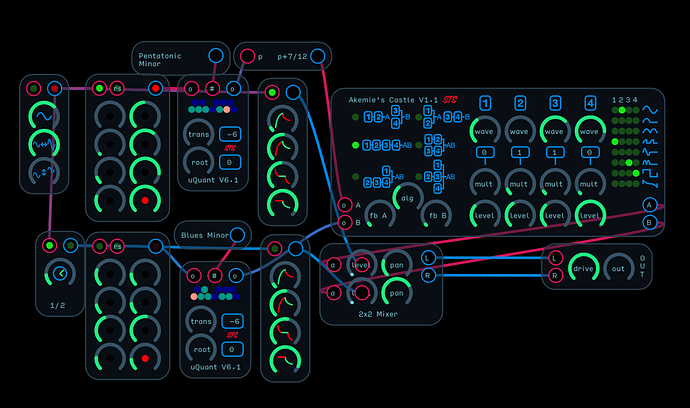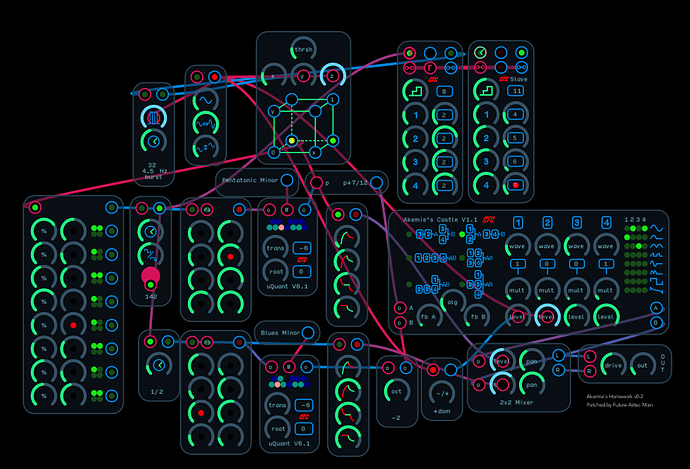I was goofing around with Akemie’s Castle and noticed that the
Uquant bundled was an older version. As it is supposed to be more efficient, perhaps it should be updated.
I am also wondering what the p+7/12 expression going into the A octave point is?
Maybe we could get a proper post for this on the new forum here as it is such a beautiful little machine? I am thinking about working on a track with this one.
1 Like
Since the uQuant was just part of the demo and not part of the unit itself, it probably wouldn’t be worth the time to redo the file (I’m sure there are many more that are out of date). Please feel free to use the later version if you wish. If I modify the main module, I’ll update the uQuant. The 7/12 is taking the root note coming from the quantizer and raising it a fifth (7 semitones). I’ve always liked the sound of fifths and this is a quick way to add some interest to the demo. The Akemie’s Castle was is an Audulus model of a Eurorack unit that is based on a Yamaha OPL-3 synthesizer chip that was used in early Yamaha synths and the Soundblaster PC sound card. It got me interested in PM synthesis in general and led to the various uPop modules. It was fun to play with, but kind of heavy on CPU. I find the uPop modules to be more useful in practice. They also evolved over time. The first version used the same eight waveforms as the Castle, the second had a harmonic morph for the waveform selection, the third changed that to a linear morph to reduce CPU, and the latest version (uPop DX)v only has a sine wave. Earlier versions only offered internal feedback. I didn’t think the additional waveforms added enough to make it worth the extra overhead. I haven’t had a chance to post the series on the new forum, but they should all be in the same thread on the old site.
1 Like
I really like the sound of this and, from what I have seen, it is one of the most interesting things in Audulus. The CPU is actually not too bad and it came down when I updated uQuant in the patch. I have it arranged here as a playable synth. Is there anything glaring you see that I could/should change? Any synth that makes me want to make music is a good synth 
Akemies’s Castle V1.1 modified.audulus (604.6 KB)
4 Likes
Thanks for the compliment. It was a lot of fun to build. @robertsyrett posted a video of the hardware module on the old forum and got me started. I was wondering why you have a quantizer in between your MIDI keyboard node and the Castle? The notes from the MIDI module should already be quantized at semitones, so the uQuant shouldn’t really be necessary (of course it does keep you from playing any notes that aren’t in the scale you selected).
1 Like
Part of the reason is that I need to learn more about all of the basic functions like scale quantization, which people like to give definitions that are simple to look up but don’t quite get to the deeper Eurorack type understanding that goes with knowing your way around the Ornament and Crime module, for example.
And, yes, I don’t know scales so if I can limit myself from hitting the wrong note, that’s why I would use it.
2 Likes
The pentatonic scales are pretty good for improvising. I often use them with the Turing Machine module for a melodic line. Choose the major or minor depending on the chords you’re playing over. For a blues feel, try the blues major or minor. They’re similar to the pentatonic scales with an additional “blue” note. One of the instruments I play, the mountain dulcimer, has a diatonic fret board, which is similar to playing through the quantizer. It doesn’t have all the notes, only the notes in a D major scale. As long as you’re in D major, you can’t go wrong. I also noticed that my son’s Push lets you select from various scales when you’re assigning notes to the pads. I found it confusing, but I supposed you’d get use to it after a while. As sloppy as my keyboard playing has gotten, I might have to give that a try myself. It might save me from a least a few of those “clunkers” 
1 Like
Another protip: use a major/minor scale for your pads/chords, then set the bass line to only play the pentatonics of that scale. Avoids some squishy sounding progressions.
Do you mean inside the module? Or when you are sequencing notes?
1 Like
When you’re sequencing notes. It’s really just a composition technique to have the bass lines play on the pentatonic of that scale. It will result in tighter sounding basslines.
You’d have to have a separate quantizer module for the bass that is set to the pentatonic of that scale.
Yes, but in that example, you’re using a sine LFO for a clock, which doesn’t work for triggering envelopes (if you examine them you’ll notice they’re not doing anything in the patch). Also, the bass line would usually be lower - the point is to anchor the sound there with the low notes.
I tried to follow your directions on the quantization method and fix the clocking. The Reticulated Gate Sequencer and the uQuant modules eat too much CPU for my iPad to play this. Any suggestions from anyone?
Akemies’s Homework v0.2.audulus (1.2 MB)
1 Like
Really nice! I’m loving the funky yet melancholic vibe, and the variety of events is pleasantly spaced out so it feels organic. 

1 Like





